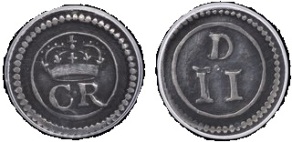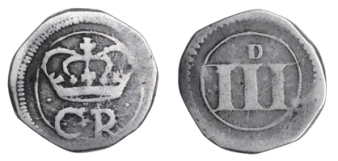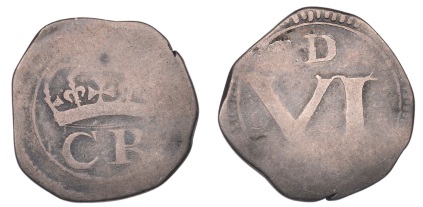Introduction
The 1642 ‘Lords Justices’ issues were followed in 1643 by a larger (fourth) emergency issue of better made, but still crude, silver coins. These are collectively known as ‘Ormonde Money’ since they were issued by the Lord Justice, the Earl of Ormonde (James Butler) some time between 1643-1644.
- Ormonde’s active career began in Ireland had begun in 1633 when he was appointed as ‘Head of Government in Ireland’ under the auspices of Thomas Wentworth, 1st Earl of Strafford, by whom Ormonde was treated with great favour.
- Wentworth planned large scale confiscations of Catholic-owned land, both to raise money for the crown and to break the political power of the Irish Catholic gentry – a policy which the converted Protestant Ormonde supported.
- This policy infuriated all of Ormonde’s Irish relatives, the many branches of the powerful Catholic ‘Old English’ Butler family
- It drove many of them into opposition to Wentworth and ultimately into armed rebellion
- In 1640, Wentworth was re-called to attend to the Second Bishops’ War in England
- Ormonde was made commander-in-chief of the forces in Ireland
- Meanwhile, Wentworth fell out with both Parliament and his king, leading to his eventual execution in May 1641
Ormonde Money
These coins were almost exclusively made from silver plate, cut and struck into a number of denominations with simple patterns including their value in ‘old style’ Roman numerals, where ‘4’ is written as ‘IIII’ and not the modern style ‘IV’ as seen on many modern coins. Sometimes, on particularly well-preserved examples, one can see the original patterns on the silver plate, and, very occasionally, a contemporary hallmark from the Dublin Silversmith’s Guild.
The heavier crowns and halfcrowns turn up more frequently at auction and tend to be better preserved than the smaller denomination (and lighter) pence coins – presumably the lighter coins were circulated more, show more ‘wear and tear’ and, therefore, were more likely to be melted down at a later date. The crowns and halfcrowns also show more die varieties due to more specimens being available for study.
Ormonde Twopence (2d, but also known as a Half-Groat)
- obv. crowned C R (for Charles Rex) in double circle,
- rev. II (denoting 2 pence, or half-groat) within double circle
- Seaby S.6550 / Weight: 0.81 grammes
Ormonde Threepence (3d)
- obv. crowned C R in double circle,
- rev. III (denoting 3 pence) within double circle
- Seaby S.6549 / Weight: 1.36 grammes
Ormonde Groat (4d)
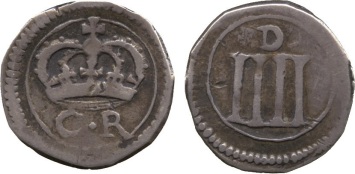
Ormonde Groat, crown over C.R, rev mark of value, large D Nick on crown, toned, about very fine and rare
- obv. crowned C·R within double circle,
- rev. IIIId (denoting 4 pence, or one groat) within double circle
- Seaby: S.6548 / Weight: 1.8 grammes
Ormonde Sixpence (6d)
- obv. crowned C R (for Charles Rex) in double circle,
- rev. VId (denoting 6 pence) in double circle
- Seaby: S.6547 / Weight: 2.72 g
Ormonde Shilling (12d, or denoted as 1/-)
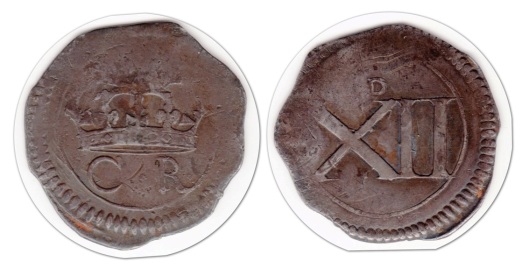
King Charles I, Ormonde Silver Shilling, weak in parts as usual near Very Fine obverse, Very Fine reverse. Obverse – Crown over CR, linear and beaded outer circles. Reverse – XII Value in circle struck from silver plate
- obv. crowned C·R (for Charles Rex) in double circle,
- rev. XIId (denoting 12 pence, or one shilling) in double circle
- Seaby: S.6546 / Weight 5.8 grammes
Ormonde Halfcrown (2s 6d, or denoted as 2/6)
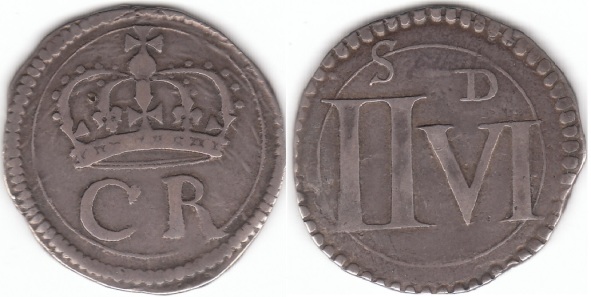
Ormonde Halfcrown. S.6545. Obv. Crown above C and R, a line circle around, and a somewhat crude blunt toothed outer border. Only cross of crown touches the inner line circle. Only the tail of the trailing R crosses the circle. A faint triangular pellet divides the C and R. The C has a near Roman top seraph, and no bottom seraph. Rev. Huge bold II, height 15.0mm, and shorter VI, height 11.3mm. All four corners of the IIVI cut across the inner line circle of 25.5mm diameter. Minute central pellet before V. An almost snakelike S with almost parallel Roman seraphs is centered above the II, and almost bisected by the line circle with bottom of top seraph of S just touching the outside of the inner circle. Well formed D, height 3.6mm, with a longer top seraph than bottom seraph, is above right side of V and closer to circle than to the V. Struck on an unusually round sterling plate flan, still showing part of original silver detail on obverse
- obv. crowned C·R (for Charles Rex) in double circle,
- rev. IIs VId (denoting 2 shillings and six pence) within double circle
- Seaby: S.6545 / Weight: 14.51 grammes
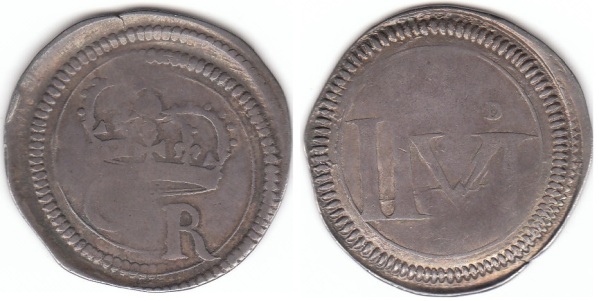
Ormonde Halfcrown Obv. Double Stuck Die, 14.65g. Obv. struck twice, the second strike being 8.5mm lower than the first, resulting in a strongly doubled outer blunt toothed circle at the top, and a doubled crown. The C appears from the first strike higher on the left, and the R appears lower from the second. Any pellet between the C and R is no longer visible. Rev. appear similarly modified as the above. Inner line circle is 27.5mm. The tall bold II is slanted down on the top to the left to about 13.5mm, while the VI remains about 11.3mm. height. The corners of the IIVI touch but do not cross the line circle. The same die crack across the bottom third of the IIVI is evident and appears about the same, as on the coin immediately above. The area of the S is worn smooth. The D is the same petite size D, height 2.4mm., as above, but now has equal length seraphs top and bottom. The left stand of the V appears thinner, and upon inspection, has been reduced, indicating this die is the third working of the same die as the above two coins. Struck on a cut fairly round sterling plate flan
Ormonde Crown (5s, or denoted as 5/-)
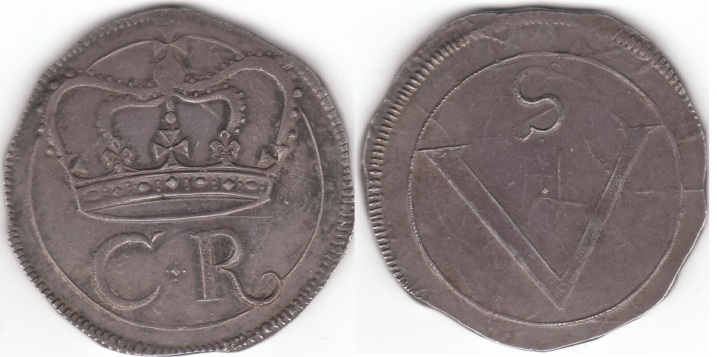
Superb Ormonde Crown. Obv. Crown above C and R, a fine line circle around, and a toothed outer border. Cross and top corners of crown and curled tail of R break circle. Diamond shaped pellet surrounded by 4 tiny pellets, above, below, and to sides, all between C and R. C with protruding top seraph but no bottom seraph. Rev. Large V, within line border, well clear of line circle at bottom and touching upper left and barely clear upper right, surrounded by plain field and outer toothed border. Tiny diamond shaped central pellet within V, snake-like S with seraphs that only protrude outward, curled backward at bottom and forward at the top, a petite round pellet below, all well clear and below the line circle. Superbly struck on a round sterling plate flan, still showing much detail of the original silver plate. Not all specimens are this round, as they are usually crudely cut from silver plate
- obv. crowned C·R (for Charles Rex) within double circle,
- rev. large V below smaller S (denoting 5 shillings) within double circle
- Seaby: S.6544 / Weight: 29.56 grammes
Who was Ormonde?
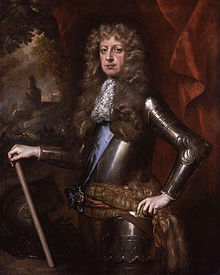
James FitzThomas Butler, 1st Duke of Ormonde, 12th Earl of Ormond, 5th Earl of Ossory, 1st Marquess of Ormond, 1st Earl of Brecknock KG, PC was an Anglo-Irish statesman and soldier, known as Viscount Thurles from 1619, Earl of Ormond from 1634 to 1642, the Marquess of Ormonde from 1642 to 1661 and the Duke of Ormonde from 1661 onwards. He was appointed commander of the Cavalier forces in Ireland and, from 1641 to 1647, he led the fighting against the Irish Catholic Confederation. Without actually changing sides, he found himself on the joint-Royalist-Confederate side in the fight against the Cromwellian conquest of Ireland. After a series of catastrophic defeats in this role, he lived in exile in Europe with King Charles II of England. Upon the restoration of Charles to the throne in 1660, Ormonde became a major figure in English and Irish politics, holding many high government offices, including his elevation to an English dukedom in 1682.
Early Life
James Butler was the eldest son of Thomas Butler, Viscount Thurles and of Elizabeth, Lady Thurles, daughter of Sir John Poyntz of Iron Acton in Gloucestershire. His paternal grandfather was Walter Butler, 11th Earl of Ormond.
- He was born at Clerkenwell, London, 19 October 1610, in the house of his maternal grandfather, Sir John Poyntz
- Shortly after his birth, his parents returned to Ireland. The Butlers of Ormonde were an Old English dynasty who had dominated the southeast of Ireland since the Middle Ages
- Upon the shipwreck and death of his father in 1619, this 8 year old boy was (by courtesy) styled Viscount Thurles.
- The year following that disaster, his mother brought him back to England
- Then nine years of age, he was placed at school with a Catholic gentleman at Finchley
- via the influence of his Catholic grandfather, the 11th Earl
- It was not long before James I of England, anxious that the heir of the Butlers should be brought up a Protestant, placed him at Lambeth, under the care of George Abbot, archbishop of Canterbury.
- The Ormonde estates were under sequestration and the young Lord had little for his clothing and expenses
- He appears to have been entirely neglected by the Archbishop — “he was not instructed even in humanity, nor so much as taught to understand Latin”
- At fifteen years of age, he went to live with his grandfather (then released from prison) at Drury-lane
- Unlike almost all his relatives in the Butler dynasty, he was a Protestant
- This made his relationship with the rest of his family and dependants somewhat strained, as they suffered from land confiscations and legal discrimination on account of their religion, while he did not
- Unusually for a Protestant lord brought up in London, he learned Irish – albeit a partial knowledge of which language, which proved most useful to him in later in life (when he returned to Ireland)
- At eighteen he went to Portsmouth with his friend George Villiers, Duke of Buckingham intending to join the expedition for the relief of Rochelle; a project abandoned upon the assassination of the Duke.
- He then married his cousin, Lady Elizabeth Preston, only child and heiress of Sir Richard Preston, Earl of Desmond
- Charles I gave his consent by letters patent, on 8 September 1629.
- At Christmas 1629, they married putting an end to the long-standing quarrel between the families and united their estates
- In 1634, on the death of his grandfather, he succeeded to the earldom.
The Great Rebellion
On the outbreak of the Irish Rebellion of 1641, Ormonde found himself in command of government forces based in Dublin. Most of the country was taken by the Catholic rebels, who included many of Ormonde’s Butler relatives and their followers.
- Strangely, Ormonde’s bonds of kinship were not entirely severed.
- His wife and children were escorted in safety from Kilkenny to Dublin under the order of the rebel leader Richard Butler, 3rd Viscount Mountgarret, another member of the Butler dynasty
- In spring 1642 the Irish Catholics formed their own government, the Catholic Confederation, with its capital at Kilkenny
- They began to raise their own regular troops, more organized and capable than the irregular militia of the 1641 rebellion.
- Also in early 1642 the king sent in troop reinforcements from England and Scotland.
- The Irish Confederate War was underway
- Ormonde mounted several expeditions from Dublin in 1642, that cleared the area around Dublin of Confederate forces
- He secured control of the area historically known as the Pale
- He also re-supplied some outlying garrisons, without serious contest
- The Lords Justices, who suspected him because he was related to many of the Confederate leaders, recalled him from command, after he had succeeded in lifting the siege of Drogheda in March 1642
- In April he relieved the royalist garrisons at Naas, Athy and Maryborough
- On his return to Dublin he won the Battle of Kilrush against a larger force
- Ormonde mounted several expeditions from Dublin in 1642, that cleared the area around Dublin of Confederate forces
- He received the public thanks of the English Parliament and a monetary reward
- In September 1642 was put in command of all Royalist forces in Ireland with a commission direct from the king
In March 1643, Ormonde ventured his troops to New Ross, deep in the territory of the Catholic Confederation, and won a small but indecisive victory there (Battle of New Ross) before returning to Dublin.
- Nevertheless, Ormonde was in a very difficult situation.
- The Confederates held two thirds of the island.
- The English Civil War, started in September 1642, had removed the prospect of more reinforcements from England
- Worse still, the king desired to recall troops from Ireland to fight his cause in England.
In addition the Scots Covenanters, who had landed an army in the northeast of Ireland at Carrickfergus to counter the Catholic rebellion in that part of the country in early 1642, had subsequently put northeast Ireland on the side of the English Parliamentarians against the king; and the relatively strong Protestant presence in and around Derry and Cork City was inclined to side with the Parliamentarians as well, and soon did so.
Isolated in Dublin, with the king seeking ways to minimize his Irish troops, Ormonde therefore agreed to a “cessation” or ceasefire with the Catholics, which began in September 1643, by which the greater part of Ireland was given up into the hands of the Catholic Confederation (leaving only districts in the north, the Dublin Pale, an area around Cork City, and certain smallish garrisons in the possession of Protestant commanders).
- This truce was vehemently opposed by the Lords Justices and the Protestant community in general in Ireland
- Soon afterwards, in November 1643, by the king’s orders, Ormonde despatched a body of his troops into England to fight on the Royalist side in the Civil War, estimated at 4,000 troops, half of whom were sent from Cork
- In November 1643 the king appointed Ormonde as Lord Lieutenant of Ireland — head of the Irish government executive
- For the previous two years the occupant of this post had not set foot in Ireland.
- Ormonde’s assigned mission was to prevent the king’s Parliamentarian enemies from being reinforced from Ireland
- He also had to deliver more troops to fight for the Royalist side in England
- He also had instructions to do all in his power to keep the Scottish Covenanter army in the north of Ireland occupied
- He was also given the king’s authority to negotiate a Treaty with the Catholic Confederation
- This would allow their troops to be redirected against the Parliamentarians.
The Irish Confederacy
Ormonde was faced with a difficult task in reconciling all the different factions in Ireland.
- The Old (native) Irish and Catholic Irish of English descent (“Old English”) were represented in Confederate Ireland—essentially an independent Catholic government based in Kilkenny—who wanted to come to terms with King Charles I of England in return for religious toleration and self-government.
- But, any concession that Ormonde made to the Confederates weakened his support among English and Scottish Protestants in Ireland.
- Ormonde’s negotiations with the Confederates were equally tortuous – even though many of the Confederate leaders were his relatives or friends
In 1644, he assisted Randall Macdonnell, 1st Marquess of Antrim in mounting an Irish Confederate expedition into Scotland. The force, led by Alasdair MacCollawas sent to help the Scottish Royalists and sparked off a civil war in Scotland (1644–45).
- This turned out to be the only intervention of Irish Catholic troops in Britain during the Civil Wars
- But it set a dangerous precedent and proved that Irish troops could and would fight in Britain
On 25 August 1645, Edward Somerset, 2nd Marquess of Worcester, acting on behalf of King Charles, signed a treaty in Kilkenny with the Irish Catholic Confederates without first airing the terms of the treaty with the Irish Protestant community.
- Irish Protestant opposition turned out to be so intense, that Charles was forced to repudiate the treaty almost immediately out of fear of ceding almost all Irish Protestant support to the other side in the English civil war.
On 28 March 1646, Ormonde, on behalf of the king, concluded another treaty with the Confederates which granted religious concessions and removed various grievances.
- However, the Confederates’ General Assembly in Kilkenny rejected the deal, partly due to the influence of the pope’s ambassador (nuncio) Giovanni Battista Rinuccini, who worked to dissuade the Catholics entering into a compromise.
- The Confederates called off their truce with Ormonde, and arrested those among their number who had signed the treaty with Ormonde.
Ormonde then judged that he could not hold Dublin against the Confederates. In order to save Protestant Dublin – the bastion of English rule in Ireland – he therefore applied to the English Long Parliament for help and signed a treaty with them on 19 June 1647 giving Dublin into the hands of the Parliamentarians on terms which protected the interests of both royalist Protestants and Roman Catholics who had not actually entered into rebellion.
- At the beginning of August 1647, Ormonde handed over Dublin, together with 3,000 royalist troops under his command, to the Parliamentarian commander Michael Jones, who had recently arrived from England with 5,000 Parliamentarian troops
- Ormonde in turn sailed for England, remarking of his surrender that he “preferred English rebels to Irish ones”
- This new, combined Royalist and Parliamentarian force soon won a major battle against the Catholic Confederates
- Known as the Battle of Dungan’s Hill, it took place in Co Meath, in August 1647
- The Parliamentarian victory there destroyed the Irish Confederate forces’ Leinster army
- It contributed to the collapse of the Confederate cause
- It gave confidence to the idea that a Cromwellian campaign in Ireland would be successful
Commander of the Royal Alliance (Royalist & Confederates) in Ireland
Ormonde attended King Charles during August and October 1647 at Hampton Court Palace, but in March 1648, in order to avoid arrest by the Parliament, he joined the Queen and the Prince of Wales at Paris. In September of the same year, the pope’s nuncio having been expelled, and affairs otherwise looking favourable, he returned to Ireland to endeavour to unite all parties for the king.
- The Irish Confederates were now much more amenable to compromise
- 1647 had seen a series of military disasters for them at the hands of English Parliamentarian forces under Jones
- They needed help
- On 17 January 1649 Ormonde concluded a peace with the rebels on the basis of the free exercise of their religion
- Upon the execution of Charles I (30 January 1649) Ormonde proclaimed Charles II as the rightful king
- Charles II, although in exile, made Ormonde a Knight of the Garter in September 1649
- Ormonde was placed in command of the Irish Confederates’ armies and also English Royalist troops who were landed in Ireland from France
However, despite controlling almost all of Ireland before August 1649, Ormonde was unable to prevent the conquest of Ireland by Cromwell in 1649-50. Ormonde tried to re-take Dublin in August 1649, but was routed at the battle of Rathmines. Subsequently, he tried to halt Cromwell by holding a line of fortified towns across the country
- However, the New Model Army took them one after the other, beginning with the Siege of Drogheda in September 1649.
- Ormonde lost most of the English and Protestant Royalist troops under his command when they mutinied, and went over to Cromwell in May 1650
- This left him with only the Irish Catholic forces, who distrusted him greatly.
- Ormonde was ousted from his command in late 1650 and he returned to France in December 1650.
- A synod held in at the Augustinian abbey in Jamestown, County Leitrim, repudiated the Duke and excommunicated his followers.
- In Cromwell’s Act of Settlement 1652, all of Ormonde’s lands in Ireland were confiscated and he was excepted from the pardon given to those Royalists who had surrendered by that date.
Ormonde, though desperately short of money, was in constant attendance on Charles II and the Queen Mother in Paris, and accompanied the former to Aix and Cologne when expelled from France by the terms of Mazarin’s treaty with Cromwell in 1655.
- In April 1656 Ormonde was one of two signatories who agreed the Treaty of Brussels, securing an alliance for the Royalists with the Spanish court.
- In 1658, he went disguised, and at great risk, on a secret mission into England to gain trustworthy intelligence as to the chances of an uprising.
- He attended the king at Fuenterrabia in 1659, and had an interview with Mazarin and was actively engaged in the secret transactions immediately preceding the Restoration.
Ormonde & The Restoration
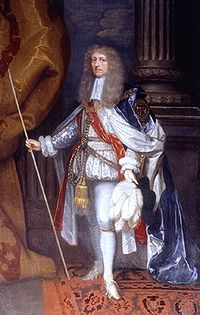
On the return of Charles II to England as king, Ormonde was appointed a commissioner for the Treasury and the navy, made Lord Steward of the Royal Household, a Privy Councillor, Lord Lieutenant of Somerset (an office which he resigned in 1672), High Steward of Westminster, Kingston and Bristol, Chancellor of Trinity College, Dublin, Baron Butler of Llanthony and Earl of Brecknock in the peerage of England; and on 30 March 1661 he was created Duke of Ormonde in the Irish peerage and made Lord High Steward of England, for Charles’s coronation that year. At the same time he recovered his enormous estates in Ireland, and large grants in recompense of the fortune he had spent in the royal service were made to him by the king, while in the following year the Irish Parliament presented him with £30,000. His losses, however, according to Carte, exceeded his gains by nearly £1 million.
On 4 November 1661, he was once more appointed Lord Lieutenant of Ireland, and busily engaged in the work of settling that country. The main problem was the land question, and the Act of Explanation was passed through the Irish parliament by Ormonde, on 23 December 1665.
- He vehemently opposed the Importation Act 1667 prohibiting the importation of Irish cattle
- He retaliated by prohibiting the import into Ireland of Scottish commodities, and obtained leave to trade with foreign countries
- He encouraged Irish manufactures and learning – the Irish College of Physicians was incorporated under him
- In his estates in Carrick-on-Suir in Co Tipperary, he was responsible for establishing the woollen industry in the town in 1670
He had great influence over the appointment of judges: while he naturally wished to appoint to the Bench men of legal ability, a record of loyalty to the Crown was also generally required.
- He was prepared to appoint judges of Gaelic descent, like James Donnellan
- He also appointed some of ‘known Roman Catholic’ leanings
- Ormonde had ever loved, he loved to the end. Himself a merciful man, he encouraged the Irish judges to show a similar spirit of mercy; as he remarked, a man who has been reprieved can later be hanged, but a man who has been hanged can never be reprieved.
- In general the judges followed his example and, by the standards of the age, were merciful enough.
Ormonde soon became the mark for attack from all that was worst in the court of Charles II
- Buckingham especially did his utmost to undermine his influence.
- Ormonde’s almost irresponsible government of Ireland during troubled times was open to criticism.
- He had billeted soldiers on civilians, and had executed martial law.
- He was threatened by Buckingham with impeachment.
- In March 1669, Ormonde was removed from the government of Ireland and from the committee for Irish affairs.
- He made no complaint, insisted that his sons and others over whom he had influence should retain their posts
- He continued to fulfil the duties of his other offices
- He elected Chancellor of the University of Oxford on 4 August 1669
In 1670, an extraordinary attempt was made to assassinate the duke by a ruffian and adventurer named Thomas Blood, already notorious for an unsuccessful plot to surprise Dublin Castle in 1663, and later for stealing the royal crown from the Tower.
- Ormonde was attacked by while driving up St James’s Street, London on the night of 6 December 1670
- He was dragged out of his coach, and taken on horseback along Piccadilly with the intention of hanging him at Tyburn
- Ormonde, however, succeeded in overcoming the horseman to whom he was bound, and escaped
The outrage, it was suspected, had been instigated by Buckingham, who was openly accused of the crime by Lord Ossory, Ormonde’s son, in the king’s presence, and threatened by him with instant death if any violence should happen to his father.
- In 1671 Ormonde successfully opposed Richard Talbot’s attempt to upset the Act of Settlement 1662
- In 1673, he again visited Ireland, returned to London in 1675 to give advice to Charles on affairs in parliament
- In 1677, Ormonde was appointed Lord Lieutenant of Ireland for the third time
- On his arrival in Ireland he occupied himself in placing the revenue and the army upon a proper footing.
- Upon the outbreak of the disturbances caused by the Popish Plot (1678) in England, Ormonde at once took steps towards rendering the Roman Catholics, who were in the proportion of 15 to 1, powerless
- The ‘mildness and moderation of his measures’ served as the ground of an attack upon him in England led by Shaftesbury, from which he was defended with great spirit by his own son Lord Ossory.
- While wary of defending Oliver Plunkett publicly, in private he denounced the obvious falsity of the charges against him – of the informers who claimed Plunkett had hired them to kill the King he wrote that “no schoolboy would have trusted them to rob an orchard”.
On 29 November 1682, an English dukedom was conferred upon him, and in June 1684 he returned to Ireland; but he was recalled in October in consequence of fresh intrigues. Before he could give up his government to Rochester, Charles II died; and Ormonde’s last act as Lord Lieutenant was to proclaim James II in Dublin.
- Ormonde also served as the 6th Chancellor of Trinity College, Dublin between 1645 and 1688
- although he was in exile for the first fifteen years of his tenure
- Subsequently Ormonde lived in retirement at Cornbury in Oxfordshire, a house lent to him by Lord Clarendon
- Ormonde also refused the king (James II) his support in the question of the Indulgence
- Unusually, James refused to take away his offices, and continued to hold him in respect and favour to the last.
- Despite his long service to Ireland he admitted that he had no wish to spend his last years there.
- Ormonde died on 21 July 1688 at Kingston Lacy, Dorset
- With him disappeared (arguably) the greatest and grandest figure of the times
- Ormonde was buried in Westminster Abbey on 1 August 1688
- Ormonde died on 21 July 1688 at Kingston Lacy, Dorset
